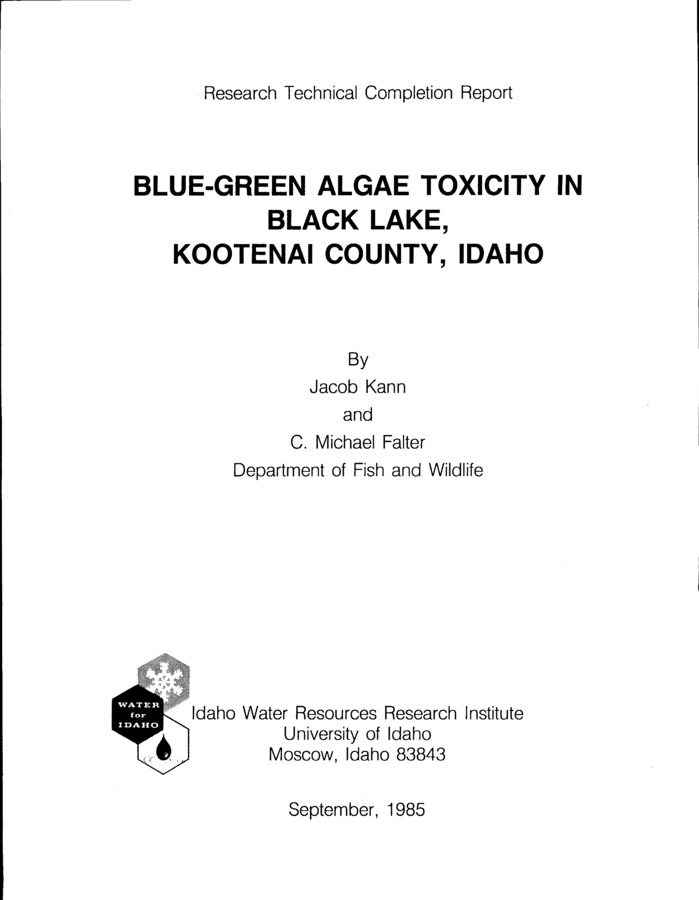PDF
Blue-green algae toxicity in Black Lake, Kootenai County, Idaho. Research technical completion report Item Info
- Title:
- Blue-green algae toxicity in Black Lake, Kootenai County, Idaho. Research technical completion report
- Authors:
- Kann, Jacob; Falter, Michael C.;
- Contributors:
- Idaho Water Resources Research Institute; IWRRI
- Date:
- 1985-09
- Description:
- Increasing occurrences of explosive growths or blooms of blue-green algae in lakes throughout the western United States have been linked to recreational use, sewage inputs, and non-point runoff associated with agriculture and grazing. In certain instances these blooms produce a toxin which can be lethal to fish, aquatic invertebrates, mammals and humans. Black Lake in northern Idaho has experienced massive late summer and fall growths of a toxic algae, Nostoc commune. At times, demonstrated fatal toxicity to cattle and small mammals has resulted in three of the last four years. Since little is known of the exact environmental conditions required to cause toxicity, environmental and phytoplankton parameters were monitored throughout the lake during summer and fall, 1984. Although conditions seemed favorable, and other blooms were intermittent through the summer-fall 1984, Nostoc did not develop to bloom proportions and toxicity did not occur. Algal assay results showed that algal growth potential ranged in the very productive range of -1 9.60 to 12.16 mg dry weight 1 /14 days for the late summer-early fall period. The limiting nutrient switched from phosphorus to nitrogen during the fall months, also indicating the potential for a Nostoc bloom. All indicators showed that Black Lake was highly productive in 1984 despite the absence of a toxic Nostoc bloom. Water transparency ranqed from 0.8 to 3.4 m, averaging 1.2 m from June to October. pH values went as high as 8.2, with the total absence of CO2 in some of the littoral areas. Dissolved oxygen values were at super saturated levels throughout most of the sampling regime. Diatoms (Fragilaria sp., Melosira sp., and Asterionella sp.) dominated the phytoplankton composition with Nostoc only showing up in early August. Chlorophyll 11 a11 values correlated with phytoplankton trends, with highs of 15 to 31 mgl-1, and lows of 0 to 5 mgl-1. The fact that Black Lake is clearly eutrophic, and that the potential for a blue-green bloom was present but did not materialize, may possibly be explained by two factors ... climatological trends and stratification pattern. The absence of a well developed hypolimion along with excessive cloudiness and lack of a protracted calm, bright, and warm fall may have accounted for the lack of a toxic bloom in Black Lake during 1984.
- Subjects:
- cyanophyta phytoplankton toxicity
- Location:
- Black Lake, North Idaho; Coeur d'Alene River
- Idaho County:
- Adams County
- Latitude:
- 47.45
- Longitude:
- -116.66
- Collection:
- Coeur d'Alene Basin
- Series:
- Water for Idaho
- Source:
- Idaho Water Resources Research Institute, University of Idaho
- Identifier:
- IWRRI Number 198508
- Publisher:
- Idaho Water Resources Research Institute, University of Idaho
- Contributing Institution:
- University of Idaho
- Type:
- Text
- Format:
- application/pdf
- Cataloger:
- wbv
- Date Digitized:
- 2012
- Language:
- eng
Source
- Preferred Citation:
- "Blue-green algae toxicity in Black Lake, Kootenai County, Idaho. Research technical completion report", Idaho Waters Digital Library, University of Idaho Library Digital Collections, https://www.lib.uidaho.edu/digital/iwdl/items/iwdl-cda_kann_1985.html
Rights
- Rights:
- In copyright, educational use permitted. Educational use includes non-commercial reproduction of text and images in materials for teaching and research purposes. For other contexts beyond fair use, including digital reproduction, please contact the University of Idaho Library Special Collections and Archives Department at libspec@uidaho.edu. The University of Idaho Library is not liable for any violations of the law by users.
- Standardized Rights:
- http://rightsstatements.org/vocab/InC-EDU/1.0/

